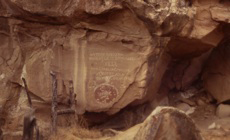Early Peoples: The White Mesa Utes
|
The Ute origin story illustrates the relationship the Utes have with their homeland and other tribal peoples. The Utes are part the Numic speaking peoples of the Uto-Aztecan language family. The Ute language, Yutish Genus, or Eastern Numic, is spoken by Utes in eastern Utah and western Colorado. The Northern Ute dialect is called Chemehuevi; the Southern Ute dialect is called Kaiba. The Utes arrived in the Great Basin around 500 A.D., and they either absorbed or displaced the preexisting Fremont Culture. They were the dominant group in the region by 1000 A.D. The Utes spread across the area and formed twelve separate bands throughout Utah and Colorado. These bands shared a common language and beliefs but lived independently and, except for occasional gatherings, remained in their own territory. The Utes gathered seeds and hunted small animals throughout the year, and they moved to different areas depending on the food and shelter available. The arrival of the horse during the 1600s brought about a major shift in Ute culture and life. They became noted raiders and hunters and traveled more quickly and farther than before. With easier access to food like buffalo, the Utes began to live in larger communities. |


 The Utes trace their origin to Sinauf, a god who is half man, half wolf. Along with his brothers, Coyote and Wolf, Sinauf kept the world in balance. In preparation for a long journey, Sinauf made a magical bag that he filled with sticks. All the sticks were different, and when placed in the bag they became people. As Sinauf put more sticks in the bag, the people became noisy. Sinauf’s brother Coyote grew curious from the noise, so he cut a little hole in the bag with his flint knife and peeked in. He laughed at the strange new creations and their many songs and languages. When Sinauf was ready to begin his journey to the high mountain Una-u-quich, he threw the magic bag over his shoulder. As he walked, the people in the bag began jumping out of the hole in small groups, forming families, bands, and tribes. When Sinauf reached the high mountain, he noticed the hole in the bag and how light it had become. Only the people at the very bottom were left in the bag. Sinauf lifted them out of the bag and said, “My children, I will call you Utikas, and you shall roam these beautiful mountains. Be brave and strong.” He then carefully put each in a special place.
The Utes trace their origin to Sinauf, a god who is half man, half wolf. Along with his brothers, Coyote and Wolf, Sinauf kept the world in balance. In preparation for a long journey, Sinauf made a magical bag that he filled with sticks. All the sticks were different, and when placed in the bag they became people. As Sinauf put more sticks in the bag, the people became noisy. Sinauf’s brother Coyote grew curious from the noise, so he cut a little hole in the bag with his flint knife and peeked in. He laughed at the strange new creations and their many songs and languages. When Sinauf was ready to begin his journey to the high mountain Una-u-quich, he threw the magic bag over his shoulder. As he walked, the people in the bag began jumping out of the hole in small groups, forming families, bands, and tribes. When Sinauf reached the high mountain, he noticed the hole in the bag and how light it had become. Only the people at the very bottom were left in the bag. Sinauf lifted them out of the bag and said, “My children, I will call you Utikas, and you shall roam these beautiful mountains. Be brave and strong.” He then carefully put each in a special place. 

